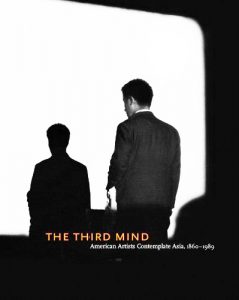
The Third Mind: American Artists Contemplate Asia, 1860-1989
“Asian artists in the United States” by D. Scott Atkinson
Excerpt from Landscapes of the Mind: New Conceptions of Nature
In spring 1953, Life magazine dubbed Guy Anderson, Callahan, Graves and Tobey, all Caucasian artists emulating Asian aesthetics, the “Mystic Painters of the Northwest.” Asian artists living in the United States, such as Chinese painter Yun Gee and his Japanese counterparts Yasuo Kuniyoshi and Paul Horiuchi, were subjected to common prejudices that had begun as early as the British and Chinese Opium Wars of the early nineteenth century, continued with the Asian immigrant labor force in the construction of the U.S. transcontinental railroad in mid-century, and was further inflamed by the Boxer Rebellion in the last decade. The fear that the United States would be swallowed up by massive Asian immigration was dubbed the Yellow Peril, a derogatory term that appeared in dime-store novels like The Mask of Fu Manchu (1932) by Sax Rohmer and in Jack London’s journalist essay about the Russo-Japanese War titled “The Yellow Peril,” published in 1909. Gee’s career was an example of the Chinese immigrant artists’ struggle to assimilate the modern European aesthetic and elevate themselves above this stereotype.
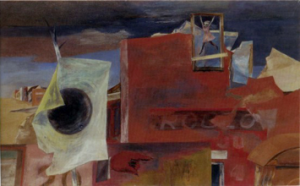
This Is My Playground (1947) – Yasuo Kuniyoshi
Kuniyoshi came to the United States in 1906 to work in agriculture. He settled in Seattle, moved to Los Angeles, then to New York in 1910. He also worked as a commercial photographer, but his heart was always in painting. In December 1941 after Pearl Harbor, although he had lived in the United States for thirty-five years, Kuniyoshi’s citizenship status changed from resident-alien to enemy-alien. He was restricted to living in his studio and not permitted to leave New York; his finances were impounded, and his camera, radio, and binoculars confiscated. The small consolation was that he was not confined to an internment camp, as were thousands of Japanese Americans living on the West Coast. Many Japanese, including Kuniyoshi, were troubled by atrocities being committed by the Imperial Army. Kuniyoshi felt guilty about Japanese war crimes – the subjugation of Manchuria (beginning in 1931), the Rape of Nanjing (1937-38), and the Bataan Death March in the Philippines (1942) – which left an indelible mark on his work during and after the war. His painting This Is My Playground (1947) uses geometric shapes but also contains the figure of a little girl framed in a window of a building, a tattered banner symbolizing the Japanese imperial flag, a pointing finger, letters and numerals, and a ruined cityscape in the background. His work shows interest in human emotions – melancholy, loneliness, and introspection – and differs from other Northwest artists by including figurative illustration, symbolic suggestion, social realism, and political content.
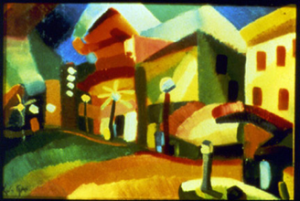
San Francisco, Chinatown (1927) – Yun Gee
Born in China, Gee immigrated in 1921 at age fifteen to the United States, where he joined his father, the owner of a small grocery store, in San Francisco. He studied at the California School of Fine Arts, now the San Francisco Art Institute. Rather than follow a traditional Eastern aesthetic, Gee gravitated toward European modernism, especially Orphism – a derivation of Cubism coined by the French poet Guillaume Apollinaire. Apparent in his paintings of San Francisco’s Chinatown, Gee’s Orphism combined Cubist structure with a high-key palette. The work embodies Teng’s statement that whereas Chinese art is linear, Western art is the “massing of different colors to make form.” The bright colors in San Francisco, Chinatown (1927) are juxtaposed as soft, geometric shapes with only their form and color alone to indicate meaning. Even what appears to be a street lamp near the center of the painting, radiating light might – due to its lack of delineation – be seen as a palm tree. Art writers have assigned Asian influences to Gee’s work, however, the paintings themselves provided little evidence to support the claim. Gee saw his work as wholly Western; when asked why he did not paint in the traditional Chinese manner he replied, “Because I am living in a modern industrial society.”
In the 1950s, Horiuchi combined calligraphy with Abstract Expressionism, well represented in his painting December #2 (1959). This gouache on paper, a traditional Northwestern medium, is a monochromatic assemblage of torn shapes, crowded with subtle nuances in an “overall atmosphere foggy luminosity. He created his first major collage in 1954 after the medium had become popular among artists like George Braque, Juan Gris, and Pablo Picasso. Horiuchi’s palette became increasingly monochrome, and he drew on his heritage by selecting calligraphic patterns and motifs that relate to the “white writing” of his friend Tobey. Both artists were familiar with the Japanese tradition of decorating calligraphy texts, known as kumogami (cloud paper) and uchigumori (pounded cloudiness), which contain dyed fibers mixed with paper to form cloudlike patterns.
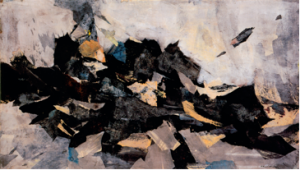
December #2 (1959) – Paul Horiuchi
Born in Japan, Horiuchi came to the United States in 1922 at age sixteen and lived much of his adult life near his family in Seattle, where he came under the influence of Tobey. He owned an antique shop, which Tobey often visited to discuss art. He expressed an interest in ink paintings, and Horiuchi gave him a Japanese brush and sumi ink. Tobey produced ninety paintings in swift order, one of which hung in Horiuchi’s studio for many years. In letter to Horiuchi, Tobey would always give the same advice: “Be Yourself.” Horiuchi recalls thinking, “Easy to say; hard to do. What does it mean to be yourself in art? I think it means to work with your own rhythm.” It was the exploration of Asian art that lead a select few American modernists to the discovery of the internal rhythms of nature, which opened modes of expression unavailable to those simply mimicking the European models championed by Stieglitz. In turn, what they discovered within themselves was a synchronicity with nature flowing from their own inner eye.
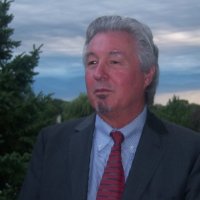
D. Scott Atkinson is a fine arts professional whose acknowledged leadership takes the finest collections to new levels. His 25 years of curatorial practice and collections expertise define him as one of the most respected leaders in the field of American Art. As the premier Curator for the Musée d’ArtAméricain in Giverny, France, he was instrumental in bringing American art onto the international stage. With over 100 exhibitions and collection presentations to his credit, Mr. Atkinson has written extensively on such major American artists as: Winslow Homer, James Abbott McNeil Whistler, Theodore Robinson, William Merritt Chase and George Bellows.
•BACK•